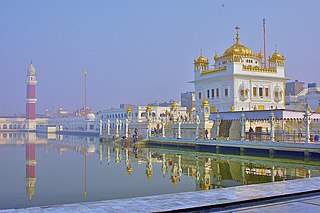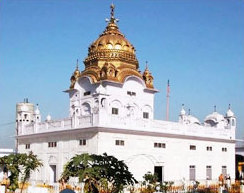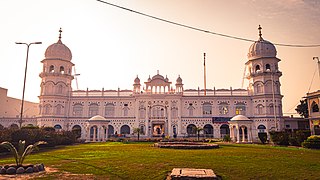
A gurdwara or gurudwara is a place of assembly and worship for Sikhs but its normal meaning is place of guru or "Home of guru". Sikhs also refer to gurdwaras as Gurdwara Sahib. People from all faiths and religions are welcomed in gurdwaras. Each gurdwara has a Darbar Sahib where the Guru Granth Sahib is placed on a takht in a prominent central position. Any congregant may recite, sing, and explain the verses from the Guru Granth Sahib, in the presence of the rest of the congregation.

Tarn Taran Sahib is a city in the Majha region of the state of Punjab, in northern India. It is the district headquarters and hosts the municipal council of Tarn Taran district. Gurdwara Sri Tarn Taran Sahib, a prominent Sikh shrine, is located in the central part of the city.

A Granthi is a person, female or male, of the Sikh religion who is a ceremonial reader of the Guru Granth Sahib, which is the holy book in Sikhism, often read to worshipers at Sikh temples called a Gurdwara.

Sri Muktsar Sahib district, is one of the 23 districts in the Indian state of Punjab. The capital city of district is Sri Muktsar Sahib. The district itself was historically referred as Khidrane Di Dhaab. There are 4 Tehsils in District which consists of total 234 villages. 1. Sri Muktsar Sahib 2. Lambi 3. Gidderbaha 4. Malout

Doraha is a city and a municipal council in Ludhiana district in the state of Punjab, India.

Dera Baba Nanak is a town and a municipal council in Gurdaspur district, in the state of Punjab, India. It is the sub-district headquarters of Dera Baba Nanak tehsil. It is 36 km away from Gurdaspur city, the capital of the district. Since November 2019, a corridor between India and Pakistan has been established at its shrine.
The town of Mullanpur Dakha,' also known as Mandi Mullanpur, is located in the Ludhiana district in the Indian state of Punjab. It is a nagar panchayat, a settlement in transition from rural to urban. Due to the availability of transport routes to other villages, the town serves as a marketplace of grain and other goods to the surrounding area.

Sikh architecture is a style of architecture that was developed under the Sikh Confederacy and Sikh Empire during the 18th and 19th centuries in the Punjab region. Due to its progressive style, it is constantly evolving into many newly developing branches with new contemporary styles. Although Sikh architecture was initially developed within Sikhism its style has been used in many non-religious buildings due to its beauty. 300 years ago, Sikh architecture was distinguished for its many curves and straight lines; Keshgarh Sahib and the Harmandir Sahib are prime examples.

Gurdwara Nanak Shahi is the principal Sikh Gurdwara in Dhaka, Bangladesh. It is located at the campus of the University of Dhaka and considered to be the biggest of the 9 to 10 Gurdwaras in the country. The Gurudwara commemorates the visit of Guru Nanak (1506–1507). It is said to have been built in 1830. The present building of the Gurdwara was renovated in 1988–1989. The parkarma verandah had been constructed on all four sides of the original building to provide protection.

Italian Sikhs are a growing religious minority in Italy, which has the second biggest Sikh population in Europe after the United Kingdom (525,000) and sixth largest number of Sikhs in the world. It is estimated that there are 220,000 Sikhs in Italy, constituting 0.3% of the total Italian population.

Dutch Sikhs form a religious minority in the Netherlands. They number around 15,000 and most of them live in or around Amsterdam. There are nine gurudwaras in the Netherlands.

Gurū Nānak, also known as Bābā Nānak, was the founder of Sikhism and is the first of the ten Sikh Gurus. His birth is celebrated as Guru Nanak Gurpurab on Katak Pooranmashi, i.e. October–November.

Gurdwara Janam Asthan, also referred to as Gurdwara Nankana Sahib, is a highly revered gurdwara that is situated at the site where the founder of Sikhism, Guru Nanak, was born. The shrine is located in Nankana Sahib, Punjab, Pakistan.

Hazur Sahib, also known as Takht Sachkhand Sri Hazur Abchalnagar Sahib, is one of the five takhts in Sikhism. The gurdwara was built between 1832 and 1837 by Maharaja Ranjit Singh (1780–1839). It is located on the banks of the Godavari River at the city of Nanded in the state of Maharashtra, India.

Chabhal Kalan is a town in the Tarn Taran district of Punjab, India and is located 13 miles (21 km) away from Amritsar city.
Gurdwara Nagiana Sahib is a Gurudwara, or holy Sikh shrine, located in Udoke, a small village near Batala in Punjab, India. The shrine was built by the Sikh saint Sant Baba Chuggat Singh Ji, who served as the first official Sewadar (volunteer) of the shrine.

Bhai Nirmal Singh Khalsa was a Sikh Hazoori Ragi of Darbar Sahib in Amritsar, Punjab, India.
The Gurdwara Gyan Godri Sahib, also known as Gurdwara Sri Gyan Godri Sahib, meaning "treasure of knowledge" was one of the holiest Gurdwara at Har Ki Pauri, Haridwar in the state of Uttarakhand, India. It existed at the place where The Bharat Scouts and Guides office exists today at the market in Subhash Ghat of Har Ki Pauri which is verified by Municipal Corporation Haridwar records of 1935.

















